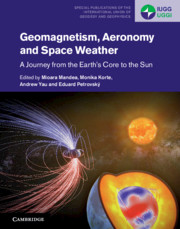Book contents
- Geomagnetism, Aeronomy and Space Weather
- Special Publications of the International Union of Geodesy and Geophysics Series
- Geomagnetism, Aeronomy and Space Weather
- Copyright page
- Contents
- Contributors
- Preface
- Part I Introduction
- Part II Geomagnetic Field
- Part III Spatial and Temporal Variations of the Geomagnetic Field
- Part IV Space Weather
- Part V Magnetic Fields beyond the Earth and beyond Today
- 17 Magnetic Field Evolution in Terrestrial Bodies from Planetesimals to Exoplanets
- 18 Solar Variability
- 19 Long- and Short-Term Geomagnetic Prediction
- Index
- References
19 - Long- and Short-Term Geomagnetic Prediction
from Part V - Magnetic Fields beyond the Earth and beyond Today
Published online by Cambridge University Press: 25 October 2019
- Geomagnetism, Aeronomy and Space Weather
- Special Publications of the International Union of Geodesy and Geophysics Series
- Geomagnetism, Aeronomy and Space Weather
- Copyright page
- Contents
- Contributors
- Preface
- Part I Introduction
- Part II Geomagnetic Field
- Part III Spatial and Temporal Variations of the Geomagnetic Field
- Part IV Space Weather
- Part V Magnetic Fields beyond the Earth and beyond Today
- 17 Magnetic Field Evolution in Terrestrial Bodies from Planetesimals to Exoplanets
- 18 Solar Variability
- 19 Long- and Short-Term Geomagnetic Prediction
- Index
- References
Summary
Prediction of geomagnetic variability depends on the accuracy of geomagnetic field modeling, dynamical modeling of source regions that contribute to geomagnetic signals, and advanced assimilation algorithms that combine effectively the results of geomagnetic field and dynamic models to make accurate estimates of the dynamic states of the sources and, therefore, accurate forecast of geomagnetic variations. Here, an overview of recent research efforts in these three research areas is provided, focusing primarily on geomagnetic variations from the dynamic outer core and from solar and lunar tidal effects, but also including a review of relevant research results and developments. Prediction of weak but periodic tidal phenomena, and of strong but chaotic secular variation showcases two very important new developments which will lead to new opportunities in geomagnetic research and application.
- Type
- Chapter
- Information
- Geomagnetism, Aeronomy and Space WeatherA Journey from the Earth's Core to the Sun, pp. 312 - 326Publisher: Cambridge University PressPrint publication year: 2019



